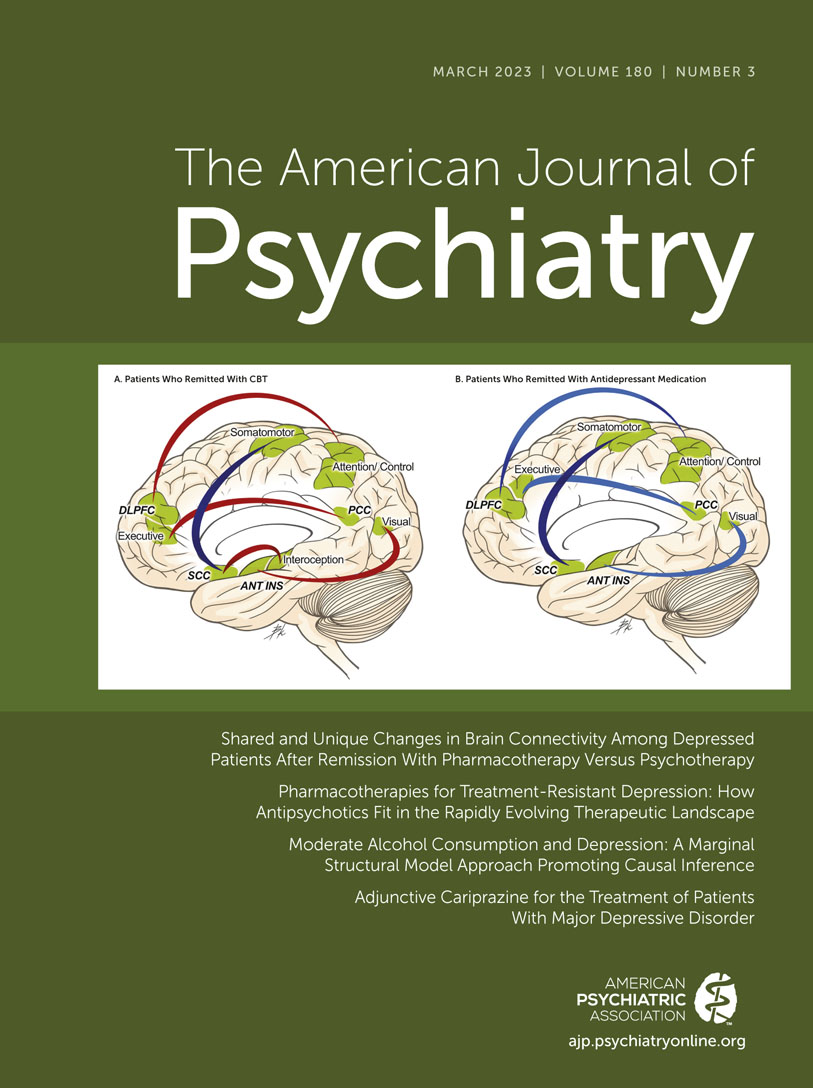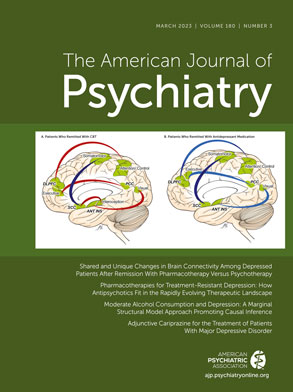In the clinical context, alcohol use is typically a problem to be reduced or eliminated. Patients presenting with depression, anxiety, or other non-substance-related mental disorders often have co-occurring alcohol or other substance use. Community-based surveys show that having an alcohol use disorder at least doubles the odds of depressive, anxiety, and other non-substance-use disorders (
1). Cessation of alcohol use is associated with substantial reductions in depressive symptoms, as demonstrated, for example, in the classic studies of Brown, Schuckit, and colleagues among veterans hospitalized with alcohol use disorder (
2,
3). This suggests a toxic effect of alcohol on depression. DSM-IV and DSM-5 (
4,
5) introduced the diagnosis of substance-induced disorders, including depression, based on such evidence. Trials of antidepressant medications in patients with co-occurring depressive disorders and alcohol use disorder often have high placebo response rates—reduction in alcohol use and improvement in mood on placebo—particularly when manual-guided counseling focused on substance use is offered to all patients in the trial (
6–
8). This can be interpreted as suggesting that treatment-related reduction in alcohol use leads to improvement in depression, again consistent with a toxic effect of alcohol on depression. Populations under stress or trauma are at increased risk for alcohol use and use disorders (
9,
10), as are those with co-occurring psychiatric disorders (
1). Self-medication may be invoked as a mechanism. Alcohol lies on a pharmacological continuum with other anxiolytic tranquilizers but is a poor anxiolytic due to its short duration of action and rapid elimination accompanied by rebound symptoms, setting up a cycle where alcohol use may be driven by alcohol-induced negative affect (
11), not to mention its side effects, and dangers. Alcohol use is associated with enormous morbidity, mortality, and social costs.
All that said, in the general population, drinking behavior exists on a continuum from abstinence to low-risk drinking to what is considered risky drinking exceeding public health guidelines—defined as more than four standard drinks per day and 14 drinks total per week for men and more than three drinks per day and seven drinks in total per week for women. Thresholds are lower for women because of smaller body size and greater absorption of alcohol through the gut than men. These guidelines for risky drinking reflect the public health imperative to prevent heavy drinking and the substantial morbidity and mortality associated with it. In this context, the article by Visontay and colleagues in this issue of the
Journal (
12) presents intriguing evidence that low to moderate drinking, below the guideline-defined level of risky drinking, across early and middle adulthood may be protective against the development of depression in midlife (age 50) when compared with abstinence from alcohol.
Observational studies applying traditional regression methods have detected J- or U-shaped relationships between levels of drinking and risk of depression, with the lowest risk among light or moderate drinkers and higher risk among abstainers as well as above-guideline or risky drinkers (
13). Visontay et al. sought to challenge these findings by examining data from the National Longitudinal Survey of Youth 1979 (NLSY1979), which followed a U.S.-based cohort of teenagers and young adults first interviewed at ages 14–22 and followed until age 50, applying the new statistical technique of marginal structural modeling (MSM). The authors reason that previous findings may be due to the confounding and bias that are pitfalls of traditional statistical methods and would be better addressed by MSM. They hypothesize that applying MSM with a robust set of covariates will reveal a simple linear relationship between alcohol consumption and subsequent risk of depression, with the risk lowest for abstainers and increasing from there in proportion to level of alcohol consumption. Instead, their work replicates a U-shaped pattern. The subgroup of the sample that had consistently abstained from alcohol over young and middle adulthood had a modestly increased mean score on the Center for Epidemiological Studies Depression Scale–Short Form (CES-D-SF) and a modestly increased probability of a clinically significant CES-D-SF score at age 50, compared with the subgroup that reported light or moderate alcohol intake, below guideline-based thresholds for risky drinking. The subgroup reporting risky drinking also had modestly increased depression.
MSM is one of several newer statistical techniques, including propensity score matching, that seek to establish a stronger case for a causal relationship between an exposure (in this case alcohol use over time) and an outcome (depression in midlife) from observational data. Such approaches provide an alternative where a randomized trial would not be feasible. Designed for longitudinal data with both fixed and time-varying covariates, MSM assigns weights to each observed case at each time point, based on the covariates, creating in effect a “pseudo population” control condition (
13). Randomized trials are arduous and expensive, are more suited to short-term interventions and outcomes over weeks or months rather than years, and may not select representative samples (
14). The study by Visontay et al. is valuable as a demonstration of applying MSM to a relevant clinical problem.
A statistical technique such as MSM is only as good as the data available to it, and Visontay et al. are circumspect in acknowledging the limitations, such as unmeasured confounders. Analysis of observational data produces associations from which causality is a conjecture but cannot be proven. For example, the analysis sought to correct for the “sick quitter” phenomenon by controlling for heavy drinking during adolescence, prior to measurements of drinking and depression in subsequent waves. More than half of the group that abstained during early and middle adulthood had an early history of above-guideline or risky drinking, and there could be other mental health vulnerabilities in the abstainer group that were not measured.
But how important is causality in this context, as opposed to prediction, or delineation of mechanism? As clinicians, we are not going to recommend that abstainers begin to drink, or encourage low-level drinking, given, among other reasons, the risk that some may go on to problem drinking and its manifest harms, as well as potential medical risks of long-term alcohol exposure. Rather, the association of low-level drinking with reduced risk of depression begs the question of mechanism, the exploration of which could lead to new strategies for treatment or prevention. If low-level drinking is indeed associated with reduced risk of depression, what are the mediators or moderators? Visontay et al. offer two potential explanations for a protective effect of low-level alcohol consumption. One is biological, related to putative salutary impacts on GABA or dopamine systems or inflammatory mechanisms. Future research on biological effects of sustained low-level drinking might offer clues toward medication development or toward development of biomarkers of risk for depression or targets for intervention.
The other explanation, arguably more parsimonious, is that low-level drinking reflects a healthy social life, which protects against depression. Alcohol consumption is normative in many societies worldwide, ingrained in our cultures. One potential avenue for future research would be to sample individuals from cultures where drinking is proscribed and abstinence is normative. Future research should explore what is different about persistent abstainers as opposed to low-level “social” drinkers. The possibility remains that some of the individuals in our culture who do not drink at all carry risks, perhaps abstaining due to family history of drinking (family history was not assessed in the NLSY1979) or mental health problems, or are perhaps more socially isolated. Better understanding of such pathways could lead to screening or interventions to reduce risk of depression.
Clinically, the data may be viewed as providing some reassurance that low-level, below-guideline drinking is safe for most individuals, at least regarding risk of depression, as long as it stays low. For clinicians, the priority remains to screen patients for escalation from low-level to problem-level drinking. Screening for above-guideline drinking has demonstrated efficacy in primary care settings and is a recommended practice (
15,
16). Screening for alcohol and other substance use and misuse is particularly important in psychiatric practice given the potential for disordered substance use to worsen the course of psychiatric disorders or produce substance-induced mental disorders.

